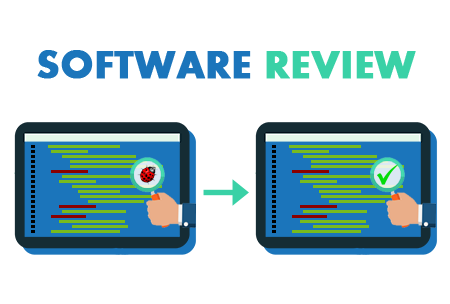


Likewise, software review is a complete process that results in carefully examining a software product in a meeting or at any event. This process is usually undertaken by project personnels, managers, users, customers, or user representatives.
In software engineering, this term is used to define review of any work done by trained personnels, who inspect the software in order to determine the positive and negative aspects of a program. Therefore, to elaborate the importance of software review, here is a discussion on the same.
Software review is an important part of "Software Development Life Cycle (SDLC)" that assists software engineers in validating the quality, functionality, and other vital features and components of the software. As mentioned above, it is a complete process that involves testing the software product and ensuring that it meets the requirements stated by the client.
It is systematic examination of a document by one or more individuals, who work together to find & resolve errors and defects in the software during the early stages of Software Development Life Cycle (SDLC). Usually performed manually, software review is used to verify various documents like requirements, system designs, codes, "test plans", & "test cases".
The reasons that make software review an important element of software development process are numerous. It is one such methodology that offers an opportunity to the development team & the client, to get clarity on the project as well as its requirements. With the assistance of software review, the team can verify whether the software is developed as per the requested requirements or not, and make the necessary changes before its release in the market. Other important reasons for Software Review are:
There are mainly three types of software reviews, all of which are conducted by different members of the team who evaluate various aspects of the software. Hence, the types of software review are:
Peer review is the process of evaluating the technical content and quality of the product and it is usually conducted by the author of the work product, along with some other developers. According to "Capacity Maturity Model", the main purpose of peer review is to provide “a disciplined engineering practise for detecting or correcting defects in the software artifacts, preventing their leakage into the field operations”. In short, peer review is performed in order to determine or resolve the defects in the software, whose quality is also checked by other members of the team.
These reviews take place in the later stages by the management representatives. The objective of this type of review is to evaluate the work status. Also, on the basis of such reviews decisions regarding downstream activities are taken.
"Software Audit" review or software review is a type of external review, wherein one or more auditors, who are not a part of the development team conduct an independent examination of the software product and its processes to assess their compliance with stated specifications, standards, and other important criterion's. This is done by managerial level people.

Formal and informal review are two very important types of reviews that are used most commonly by software engineers to identify defects as well as to discuss ways to tackle these issues or discrepancies. Therefore, to understand these important types of software review, following is a comparison of the two:
A type of peer review, "formal review" follows a formal process and has a specific formal agenda. It has a well structured and regulated process, which is usually implemented at the end of each life cycle. During this process, a formal review panel or board considers the necessary steps for the next life cycle.
Unlike Formal Reviews, Informal reviews are applied multiple times during the early stages of software development process. The major difference between the formal and informal reviews is that the former follows a formal agenda, whereas the latter is conducted as per the need of the team and follows an informal agenda. Though time saving, this process is not documented and does not require any entry criteria or large group of members.
The process of software review is a simple one and is common for all its types. It is usually implemented by following a set of activities, which are laid down by IEEE Standard 1028. All these steps are extremely important and need to be followed rigorously, as skipping even a single step can lead to a complication with the development process, which can further affect the quality of the end product.
A standard check-list is used by entry criteria in order to ensure an ideal condition for a successful review.
During this stage of the process, a responsible management ensures that the software review has all the required resources, which includes things like staff, time, materials, and tools.
To undergo a software review, an objective is identified. Based on the objective, a recognized team of resources is formed.
The reviewers are held responsible for preparing group examination to do the reviewing task.
In the end, the result made by each reviewer is combined all together. Before the review is finalized, verification of all activities is done that are considered necessary for an efficacious software review.
From the above discussion, we can conclude that software review is a vital part of "software development life cycle (SDLC)" that helps developers and other members related to the project, to improve the quality and other components of the software. With the assistance of software review, a team can effortlessly identify and resolve issues from the software product, while meeting its requirements, standards, and other necessary criteria. In short, software review is an helpful process that allows developers to deliver a quality product to the client.
Advertisement: